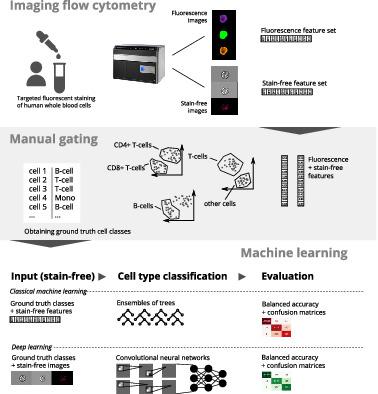当前位置:
X-MOL 学术
›
Cytom. Part A
›
论文详情
Our official English website, www.x-mol.net, welcomes your
feedback! (Note: you will need to create a separate account there.)
Classification of Human White Blood Cells Using Machine Learning for Stain-Free Imaging Flow Cytometry.
Cytometry Part A ( IF 2.5 ) Pub Date : 2019-11-05 , DOI: 10.1002/cyto.a.23920 Maxim Lippeveld 1, 2 , Carly Knill 3 , Emma Ladlow 3, 4 , Andrew Fuller 3 , Louise J Michaelis 5, 6 , Yvan Saeys 1, 2 , Andrew Filby 3 , Daniel Peralta 1, 2
Cytometry Part A ( IF 2.5 ) Pub Date : 2019-11-05 , DOI: 10.1002/cyto.a.23920 Maxim Lippeveld 1, 2 , Carly Knill 3 , Emma Ladlow 3, 4 , Andrew Fuller 3 , Louise J Michaelis 5, 6 , Yvan Saeys 1, 2 , Andrew Filby 3 , Daniel Peralta 1, 2
Affiliation

|
Imaging flow cytometry (IFC) produces up to 12 spectrally distinct, information-rich images of single cells at a throughput of 5,000 cells per second. Yet often, cell populations are still studied using manual gating, a technique that has several drawbacks, hence it would be advantageous to replace manual gating with an automated process. Ideally, this automated process would be based on stain-free measurements, as the currently used staining techniques are expensive and potentially confounding. These stain-free measurements originate from the brightfield and darkfield image channels, which capture transmitted and scattered light, respectively. To realize this automated, stain-free approach, advanced machine learning (ML) methods are required. Previous works have successfully tested this approach on cell cycle phase classification with both a classical ML approach based on manually engineered features, and a deep learning (DL) approach. In this work, we compare both approaches extensively on the problem of white blood cell classification. Four human whole blood samples were assayed on an ImageStream-X MK II imaging flow cytometer. Two samples were stained for the identification of eight white blood cell types, while two other sample sets were stained for the identification of resting and active eosinophils. For both data sets, four ML classifiers were evaluated on stain-free imagery with stratified 5-fold cross-validation. On the white blood cell data set, the best obtained results were 0.778 and 0.703 balanced accuracy for classical ML and DL, respectively. On the eosinophil data set, this was 0.871 and 0.856 balanced accuracy. We conclude that classifying cell types based on only stain-free images is possible with all four classifiers. Noteworthy, we also find that the DL approaches tested in this work do not outperform the approaches based on manually engineered features. © 2019 International Society for Advancement of Cytometry.
中文翻译:

使用机器学习进行无染色成像流式细胞术对人类白细胞进行分类。
成像流式细胞术 (IFC) 以每秒 5,000 个细胞的吞吐量生成多达 12 张光谱不同、信息丰富的单细胞图像。然而,通常,细胞群仍然使用手动门控进行研究,这种技术有几个缺点,因此用自动化过程代替手动门控将是有利的。理想情况下,这种自动化过程将基于无染色测量,因为目前使用的染色技术价格昂贵且可能会造成混淆。这些无污染测量源自明场和暗场图像通道,分别捕获透射光和散射光。为了实现这种自动化、无污染的方法,需要先进的机器学习 (ML) 方法。以前的工作已经成功地使用基于手动工程特征的经典 ML 方法和深度学习 (DL) 方法在细胞周期阶段分类上测试了这种方法。在这项工作中,我们在白细胞分类问题上广泛比较了两种方法。在 ImageStream-X MK II 成像流式细胞仪上分析了四个人全血样本。两个样本被染色以识别八种白细胞类型,而另外两个样本集被染色以识别静止和活跃的嗜酸性粒细胞。对于这两个数据集,使用分层 5 倍交叉验证对无污点图像评估了四个 ML 分类器。在白细胞数据集上,经典 ML 和 DL 获得的最佳结果分别是 0.778 和 0.703 的平衡精度。在嗜酸性粒细胞数据集上,这是 0.871 和 0.856 的平衡精度。我们得出结论,所有四种分类器都可以仅基于无染色图像对细胞类型进行分类。值得注意的是,我们还发现在这项工作中测试的 DL 方法并不优于基于手动设计特征的方法。© 2019 国际细胞计量学促进会。
更新日期:2020-03-09
中文翻译:

使用机器学习进行无染色成像流式细胞术对人类白细胞进行分类。
成像流式细胞术 (IFC) 以每秒 5,000 个细胞的吞吐量生成多达 12 张光谱不同、信息丰富的单细胞图像。然而,通常,细胞群仍然使用手动门控进行研究,这种技术有几个缺点,因此用自动化过程代替手动门控将是有利的。理想情况下,这种自动化过程将基于无染色测量,因为目前使用的染色技术价格昂贵且可能会造成混淆。这些无污染测量源自明场和暗场图像通道,分别捕获透射光和散射光。为了实现这种自动化、无污染的方法,需要先进的机器学习 (ML) 方法。以前的工作已经成功地使用基于手动工程特征的经典 ML 方法和深度学习 (DL) 方法在细胞周期阶段分类上测试了这种方法。在这项工作中,我们在白细胞分类问题上广泛比较了两种方法。在 ImageStream-X MK II 成像流式细胞仪上分析了四个人全血样本。两个样本被染色以识别八种白细胞类型,而另外两个样本集被染色以识别静止和活跃的嗜酸性粒细胞。对于这两个数据集,使用分层 5 倍交叉验证对无污点图像评估了四个 ML 分类器。在白细胞数据集上,经典 ML 和 DL 获得的最佳结果分别是 0.778 和 0.703 的平衡精度。在嗜酸性粒细胞数据集上,这是 0.871 和 0.856 的平衡精度。我们得出结论,所有四种分类器都可以仅基于无染色图像对细胞类型进行分类。值得注意的是,我们还发现在这项工作中测试的 DL 方法并不优于基于手动设计特征的方法。© 2019 国际细胞计量学促进会。











































 京公网安备 11010802027423号
京公网安备 11010802027423号